This post may contain affiliate links. Please read my full disclosure policy.

Mastering Homemade Vanilla Pastry Cream: Your Essential Guide
Embark on a delightful culinary journey with this incredibly easy Vanilla Pastry Cream recipe. Whether you’re a novice baker or a seasoned pastry enthusiast, this guide will help you create a creamy, velvety custard boasting that classic, irresistible fresh vanilla bean flavor. Forget complicated techniques; our method requires just one pot, eliminating the need for tempering. The result is so rich and dreamy, you might find yourself indulging in it straight from the spoon!
What Is Vanilla Pastry Cream (Crème Pâtissière)?
Pastry cream, universally known as crème pâtissière, is a cornerstone of French patisserie and a versatile custard filling cherished worldwide. This luxurious base elevates countless desserts, from the elegant éclairs and delicate fruit tarts to sumptuous cakes, fluffy donuts, and creamy puddings. Its presence transforms ordinary treats into extraordinary delights, making them truly irresistible.
At its heart, vanilla pastry cream is a simple yet sophisticated custard made from a harmonious blend of fundamental ingredients: sugar for sweetness, cornstarch for thickening, rich egg yolks for body and color, aromatic vanilla for its signature flavor, and creamy milk. These ingredients are gently cooked over low heat on the stovetop until the mixture achieves a luscious, thick consistency. To finish, a knob of butter is often folded in, adding an extra layer of richness and a beautiful sheen. The smooth, silky texture combined with its delicate, yet profound, vanilla flavor makes pastry cream a timeless and essential recipe every home baker should master.
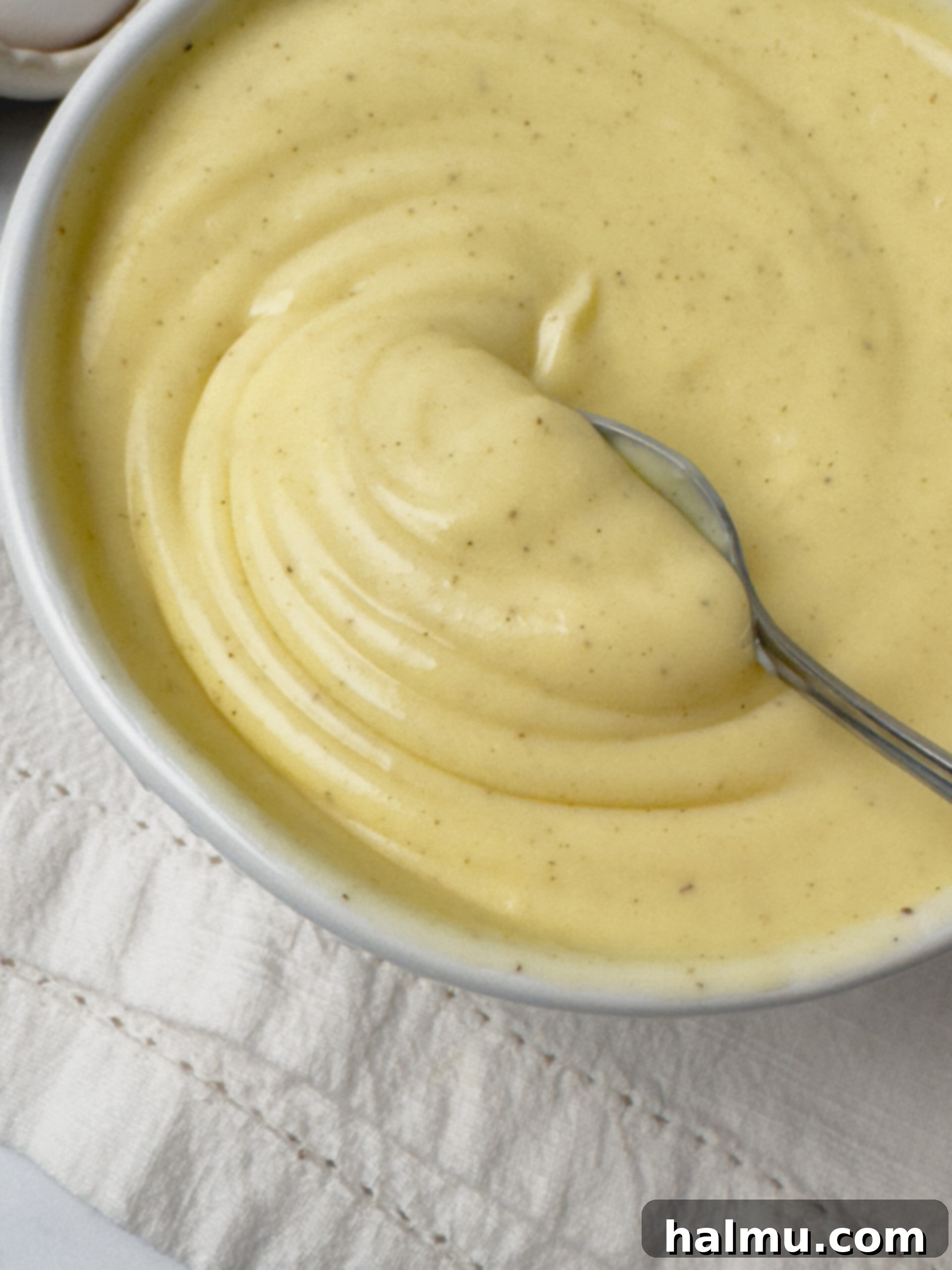
Unleashing Creativity: Delicious Pastry Cream Variations
While vanilla remains the classic and most beloved flavor profile for pastry cream, its adaptability is one of its greatest strengths. This versatile custard serves as an excellent canvas for a myriad of flavor enhancements, allowing you to customize it for any occasion or dessert craving. Beyond the traditional vanilla, the possibilities are virtually endless.
You can easily infuse your pastry cream with rich chocolate, a robust espresso kick, bright citrus notes from lemon or orange zest, vibrant fruit purees, various extracts, or even a hint of your favorite liqueur. Each addition opens up a new world of delicious possibilities, transforming your basic pastry cream into a bespoke filling perfect for your specific dessert.
Here are a few inspiring examples of how pastry cream can be transformed into unique and tantalizing flavors:
- Chocolate Pastry Cream: A decadent choice perfect for my Chocolate Mint Cream Pie. The cocoa adds depth and richness, making it incredibly indulgent.
- Lemon Pastry Cream: Bright and zesty, this variation shines in my Lemon Brûlée Bars, offering a refreshing contrast to sweetness.
- Pumpkin Pastry Cream: Ideal for autumnal treats, this spiced version provides warmth and comfort, as seen in my Pumpkin Spice Crème Brûlée Bars.
Beyond flavor, you can also modify the texture of your pastry cream. For a lighter, airier consistency, try folding freshly whipped cream into the cooled pastry cream. This creates what is known as “crème légère” (light cream), a fluffy and equally delicious filling. This lighter version is what I personally use in my irresistible Banana Pudding Cups, adding a delicate touch that perfectly complements the other components.

Key Ingredients for Perfect Vanilla Pastry Cream
Crafting the perfect vanilla pastry cream relies on a few key ingredients, each playing a crucial role in achieving its signature creamy texture and rich flavor. Understanding the function of each component can help you troubleshoot and even experiment with confidence.
- Unsalted Butter: Added at the end, butter is not just for flavor; it contributes significantly to the pastry cream’s luxurious, glossy finish and helps it set beautifully as it cools. While I prefer unsalted butter to control the seasoning, you can use salted butter and simply omit the additional salt from the recipe. Its emulsifying properties also contribute to a smoother final product.
- Granulated Sugar: This provides the essential sweetness that balances the richness of the egg yolks and milk. It also plays a role in the texture, helping to create a smoother consistency when whisked with the cornstarch and egg yolks.
- Cornstarch: A crucial thickening agent, cornstarch is what gives pastry cream its characteristic stability without adding a strong floury taste. It also acts as a protective barrier, helping to prevent the delicate egg yolks from curdling when exposed to heat, ensuring a silky-smooth custard.
- Egg Yolks: The heart of any good custard, egg yolks are essential for both richness and thickening. You’ll need the yolks from about 6 large eggs. Their fat content creates a lush mouthfeel, and their proteins coagulate when heated, setting the cream. Don’t discard the whites! They can be saved for other delightful recipes, such as my Chewy Coconut Macaroons.
- Vanilla Bean Paste (or Alternatives): This is where the iconic, fragrant vanilla flavor comes from. For the most intense and authentic taste, vanilla bean paste is highly recommended, as it contains tiny vanilla bean specks that enhance both flavor and visual appeal. Alternatively, you can scrape seeds from a whole vanilla bean pod or use a high-quality pure vanilla extract. Choose the best quality you can find, as vanilla is the star here.
- Salt: A small pinch of salt is vital. It doesn’t make the pastry cream taste salty; rather, it perfectly offsets the sweetness and amplifies all the other flavors, bringing balance and depth to the custard.
- Whole Milk: For a truly thick, creamy, and decadent custard, whole milk is indispensable. Its higher fat content contributes significantly to the desired rich texture and full flavor. I strongly advise against using non-fat milk, as it will yield a thinner custard with a compromised texture and less satisfying flavor. While some plant-based or nut milks might work, they generally won’t impart the same richness and may alter the final consistency, so proceed with caution if substituting.

Step-by-Step Guide to Making Vanilla Pastry Cream
- Combine Dry & Wet Ingredients (Initial): In a medium-sized, heavy-bottomed saucepan, whisk together the granulated sugar and cornstarch until thoroughly combined and lump-free. Next, add the egg yolks, vanilla bean paste, and salt to the sugar-cornstarch mixture. Continue whisking vigorously until the mixture is uniform, lightens in color, and resembles a pale yellow paste. This ensures that the cornstarch is evenly distributed and helps prevent lumps later on.
- Gradually Incorporate Milk: While continuing to whisk the egg mixture, slowly stream in the cold whole milk. It’s crucial to add the milk gradually and whisk constantly during this step. This technique helps to seamlessly incorporate the liquid into the thicker egg base, preventing any lumps from forming and ensuring a smooth, cohesive mixture from the start.
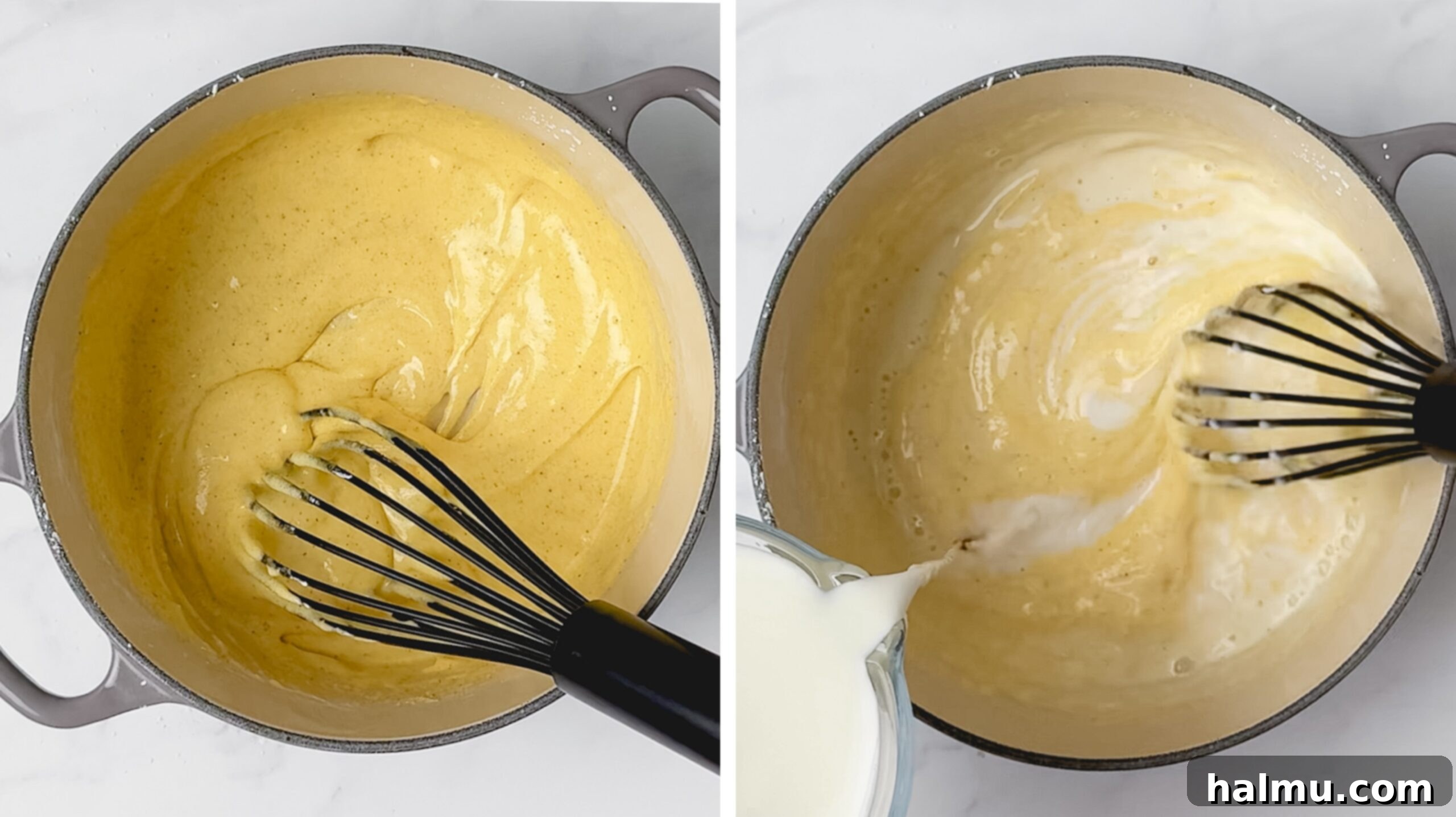
- Cook Over Low Heat & Whisk Continuously: Place the saucepan over low to medium-low heat. This gentle heat is key to preventing the eggs from cooking too quickly and scrambling. Begin to slowly bring the mixture to a boil, whisking constantly and without interruption. Do not leave the pastry cream unattended during this phase. Continuous whisking is vital to prevent sticking, scorching on the bottom, and ensuring the eggs cook evenly into a smooth custard.
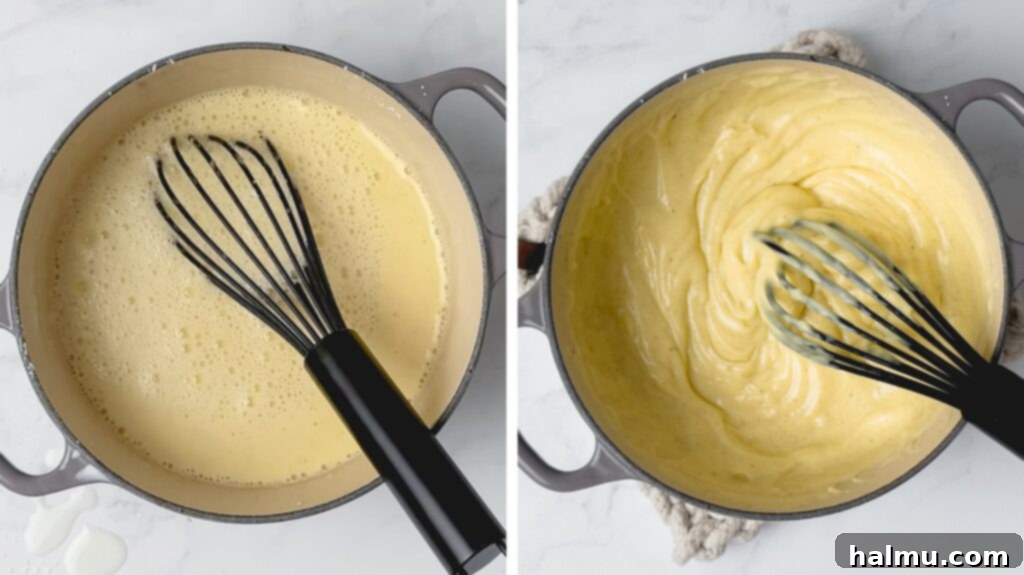
- Observe Thickening & Boiling: As the pastry cream cooks, it will gradually thicken. You’ll notice it start to bubble around the edges of the pot, then eventually begin to boil vigorously, with large, distinct bubbles popping on the surface. Once it reaches this stage, continue to boil the pastry cream for at least 10 seconds. This crucial boiling period ensures that the cornstarch properly activates and fully thickens the custard, and also cooks out any residual starchy taste, leaving you with a perfectly set and flavored cream.
- Remove from Heat & Add Butter: Immediately remove the thickened pastry cream from the heat. To ensure an impeccably smooth finish, pour the hot pastry cream through a fine-mesh strainer into a clean bowl. This step catches any small bits of egg that might have cooked too quickly, or any tiny lumps. Once strained, add the small cubes of unsalted butter and stir until they are completely melted and fully incorporated, giving the pastry cream a beautiful sheen and extra richness.

- Chill Thoroughly: To prevent a “skin” from forming on the surface as it cools, immediately press a piece of plastic wrap directly onto the surface of the hot pastry cream, ensuring there are no air pockets. Refrigerate the pastry cream until it is completely chilled, typically for several hours or overnight. This chilling period is essential for it to fully set and develop its firm, yet creamy, texture. Before using, give the chilled pastry cream a good whisk until it returns to its wonderfully smooth consistency.
Creative Ways to Use Your Delicious Vanilla Pastry Cream
Once you’ve mastered this luscious vanilla pastry cream, a world of dessert possibilities opens up! Its rich, smooth texture and sweet vanilla flavor make it an ideal filling or topping for a vast array of sweet treats. Here are some of the most delightful ways to incorporate your homemade pastry cream into your baking:
- Strawberry Crumb Bars: A delightful contrast, the creamy pastry cream beautifully complements the fruity filling and crumbly topping. Imagine a layer of rich vanilla cream enhancing the experience of every bite of my Strawberry Crumb Bars.
- Boston Cream Cupcakes: Transform simple cupcakes into elegant Boston cream desserts by piping a generous dollop of pastry cream into the center. My Boston Cream Cupcakes offer a perfect example.
- Classic French Pastries: The quintessential filling for French delights like éclairs, cream puffs, and profiteroles. Fill them generously for an authentic experience.
- Cakes and Cupcakes: Use it as a luxurious filling between cake layers or inside cupcakes for an elevated dessert experience that surprises and delights.
- Donuts and Sweet Pastries: Inject freshly baked donuts, brioche buns, or other sweet pastries with pastry cream for a burst of creamy vanilla flavor in every bite.
- Fruit Tarts: Form the delectable base for any fruit tart, providing a sweet and creamy foundation for fresh berries, sliced kiwi, or any seasonal fruit.
- Cream Pies: A natural fit for classic cream pies such as coconut cream pie or banana cream pie, adding unparalleled richness and flavor.
- Simple Dessert with Fresh Berries: For an easy yet elegant dessert, simply spoon chilled pastry cream into a glass and top with a medley of fresh berries. The vibrant fruit cuts through the richness of the cream beautifully.
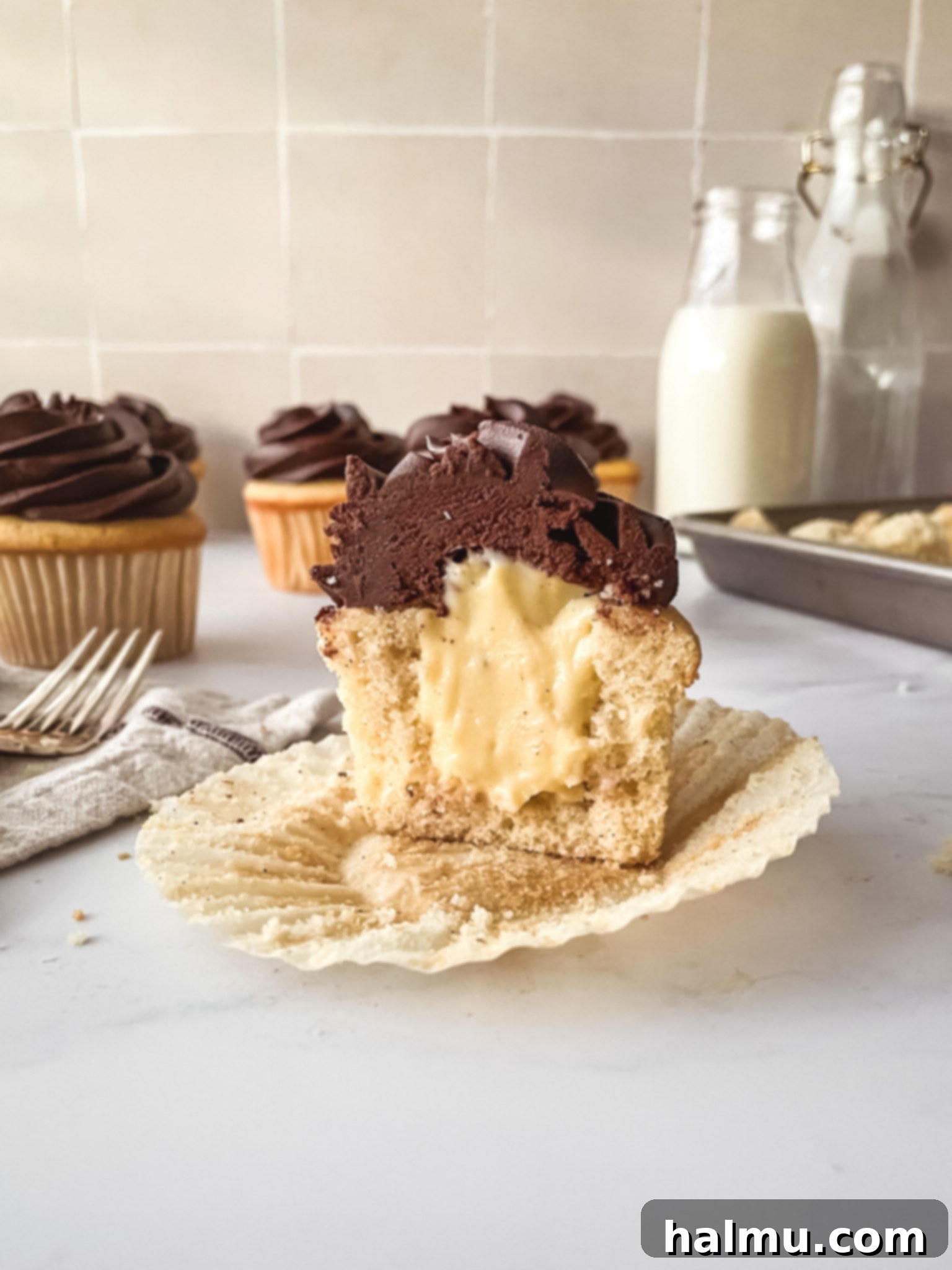
Recommended Baking Tools
Essential for whisking ingredients smoothly without scratching your non-stick cookware.
For that rich, authentic vanilla flavor and beautiful specks.
A heavy-bottomed pot ensures even heat distribution and prevents scorching.
Crucial for achieving an impeccably smooth, lump-free pastry cream.
See more in my Amazon Storefront>
Frequently Asked Questions About Vanilla Pastry Cream
What is the best way to store pastry cream?
Proper storage is key to maintaining the freshness and quality of your homemade pastry cream. Once it has cooled, transfer the pastry cream to an airtight container. The most important step is to press a piece of plastic wrap directly onto the surface of the cream, ensuring there is no air trapped between the plastic and the custard. This prevents a “skin” from forming and keeps it smooth. Store it in the refrigerator for up to 3 to 4 days. Any desserts or pastries filled with pastry cream should also be kept refrigerated until ready to serve to ensure food safety and optimal taste.
Why isn’t my pastry cream thickening?
If your pastry cream isn’t thickening as expected, it’s usually a sign that it needs more time on the heat. The cornstarch requires sufficient heat and time to fully activate and achieve its thickening potential. You may need to increase the heat slightly to medium, but be vigilant. Continue to whisk constantly and observe for a vigorous boil with large bubbles popping. The 10-15 minute cooking range provided in the recipe is an estimate; actual cooking time can vary based on your stovetop’s power and the type of pot you’re using. Keep whisking and patiently allow it to boil for at least 10 seconds once it reaches that stage.

Do I need to temper the milk and eggs?
A common concern in custard making is tempering, which involves slowly adding hot liquid to eggs to prevent them from scrambling. However, for this vanilla pastry cream recipe, tempering the milk and eggs is simply not necessary! By keeping the mixture over low to medium-low heat and whisking constantly from the moment you combine all ingredients, you effectively prevent the eggs from cooking too quickly. This continuous whisking ensures that the eggs heat up gradually and evenly with the other ingredients, leading to a perfectly smooth custard without the extra step of dirtying an additional bowl for tempering. It’s a fantastic shortcut that saves both time and cleanup!
Can I use vanilla extract instead of vanilla bean paste?
Absolutely, you can use vanilla extract as a substitute for vanilla bean paste. Since vanilla is the star flavor that truly shines in this pastry cream, it’s highly recommended to opt for a high-quality pure vanilla extract. Pure vanilla extract will provide a clean and robust vanilla flavor, ensuring your pastry cream is as delicious as possible. Avoid artificial vanilla extracts, as they can impart an undesirable aftertaste.
Is the pastry cream gluten-free?
Yes, this vanilla pastry cream recipe is naturally gluten-free, provided that your cornstarch is certified gluten-free. Cornstarch is a naturally gluten-free ingredient, and the other components (sugar, egg yolks, vanilla, salt, milk, and butter) are also inherently gluten-free. Always double-check ingredient labels to ensure no hidden gluten-containing additives, especially if you are catering to strict dietary needs.
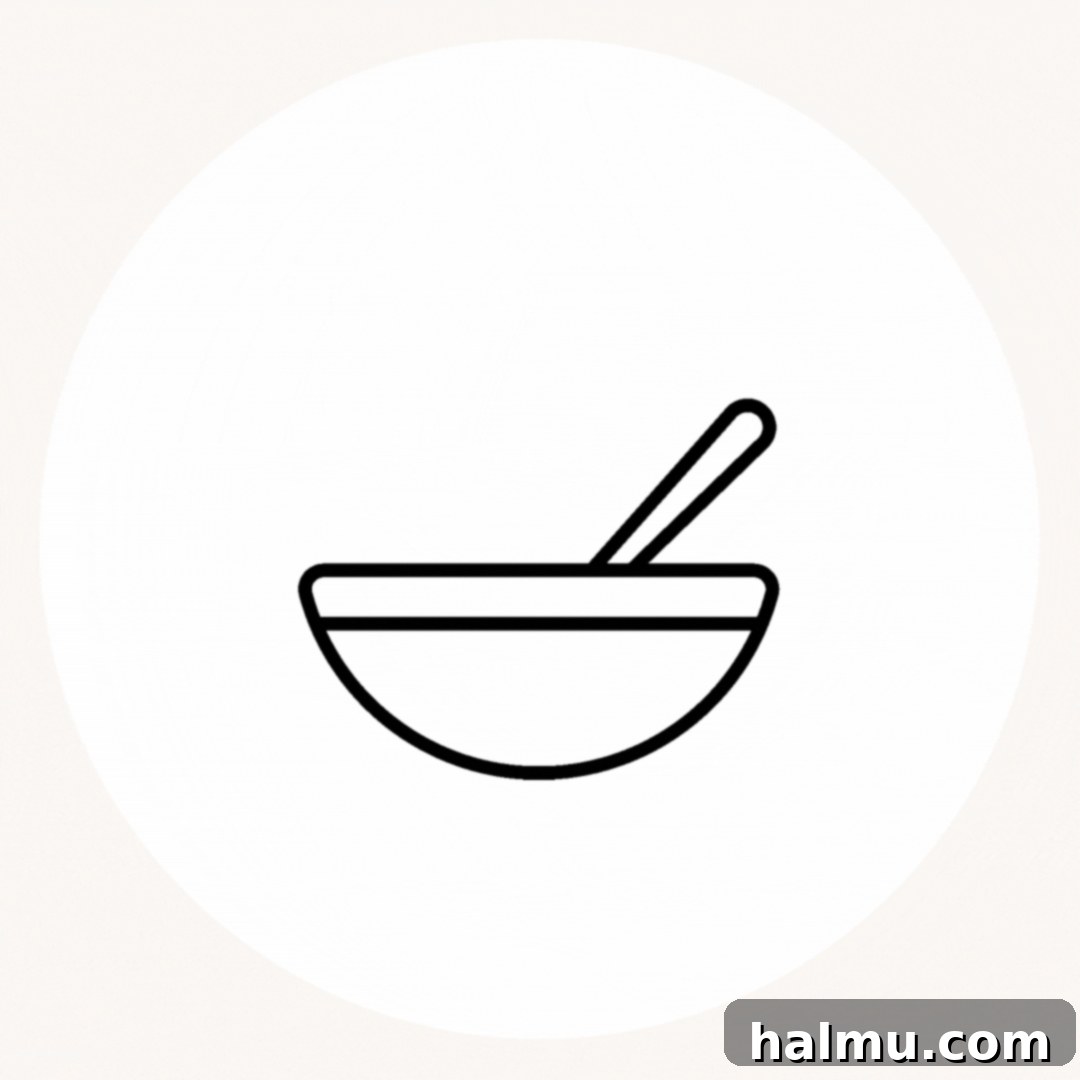
Baking Tip: Embrace the Precision of Weighing Your Ingredients!
For consistent and superior baking results, I cannot emphasize enough the benefits of using a kitchen scale to weigh your ingredients. This method is far more accurate than relying on volumetric measuring cups, which can lead to significant variations due to factors like how tightly flour is packed or how ingredients settle. Weighing ensures precise quantities every time, translating to a much higher success rate with your recipes and desserts that consistently turn out exactly as intended. Beyond the precision, it’s also a practical time-saver, reducing the number of dishes to clean! All my recipes include gram measurements, and this is the reliable kitchen scale I personally love and recommend.
Expert Tips for Flawless Vanilla Pastry Cream Every Time
Achieving perfectly smooth, creamy pastry cream is a rewarding experience. Follow these expert tips to ensure your homemade vanilla pastry cream is nothing short of perfection:
- Whisk Before Using: After your pastry cream has been thoroughly chilled, you’ll notice it has firmed up and solidified considerably. This is completely normal! Before incorporating it into any dessert, give it a good, vigorous whisk. This action will break down any congealed texture and bring it back to its wonderfully smooth, luscious, and creamy consistency, making it easy to spread or pipe.
- Maintain Low Heat: Patience is a virtue when making pastry cream. Always cook the mixture over low to medium-low heat. Applying too much heat too quickly can cause the milk to scorch at the bottom of the pan and, more importantly, can cause the egg yolks to cook too rapidly and curdle, resulting in a lumpy, unappealing texture. A gentle heat ensures a gradual and even cooking process.
- Whisk Continuously: This cannot be stressed enough – whisk, whisk, whisk! From the moment the pot goes on the stove until the cream thickens, you must whisk constantly. This continuous motion prevents the mixture from sticking to the bottom of the pan and, crucially, keeps the egg proteins moving and heating evenly. This consistent agitation is your best defense against curdled eggs and ensures a perfectly smooth and homogenous custard.
- Strain for Perfection: Even with diligent whisking, sometimes tiny bits of egg can cook faster than others, creating small lumps. To guarantee an impeccably smooth and silky pastry cream, always pass the cooked custard through a fine-mesh strainer immediately after removing it from the heat. This simple step acts as a safety net, catching any imperfections and ensuring your final product is wonderfully smooth and refined.
- Chill Completely: Chilling is an integral part of the pastry cream-making process. The cream will continue to set, firm up, and thicken significantly as it cools down in the refrigerator. Most dessert recipes specifically call for completely chilled pastry cream because its stability and texture are best when cold. Plan ahead and allow ample time for thorough chilling, typically several hours or overnight, before using it in your creations.
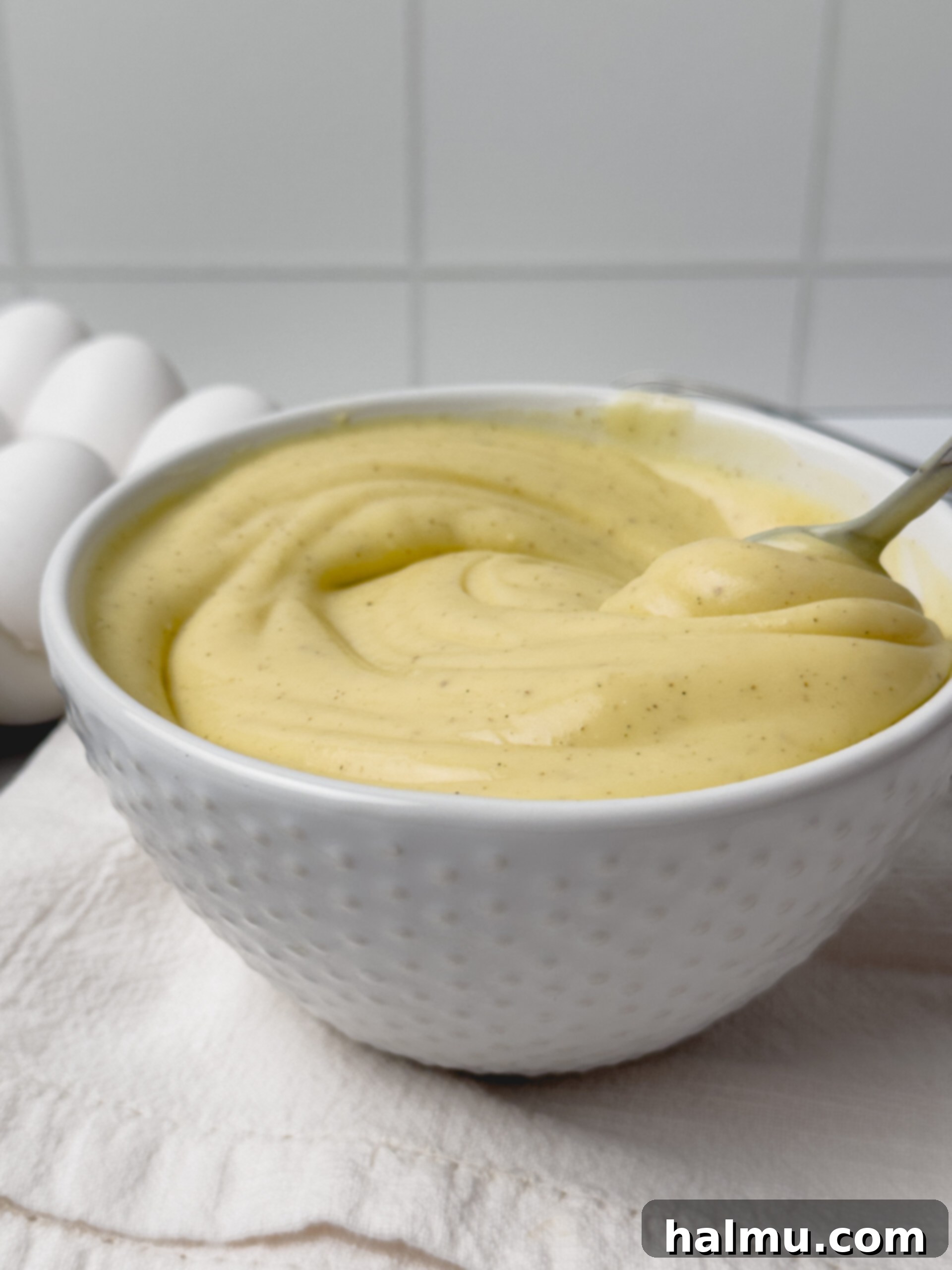
More Delicious Custard Recipes to Explore
If you’ve enjoyed making this vanilla pastry cream, you’ll love exploring other delicious custard-based desserts. Each offers its unique flavor and texture profile, providing endless opportunities for sweet indulgence:
- Chocolate Custard Brioche Donuts
- Double Layer Pumpkin Pie
- Vanilla Bean Crème Brûlée
- Chocolate Pudding
- Chocolate Pudding Cake
If you make this recipe and absolutely love it, please be sure to leave a comment and a rating below. Happy baking!

Vanilla Pastry Cream
Rich, creamy homemade Vanilla Pastry Cream. This classic custard is perfect for filling cakes, tarts, pastries, and so much more!
Author: Rachel
Print Recipe
RATE THIS RECIPE
Prep Time
5 mins
Cook Time
15 mins
Total Time
20 mins
Yield
12 ounces (about 2 cups)
Ingredients
- ½ cup (108g) granulated sugar
- 3 Tablespoons (28g) cornstarch
- 6 large egg yolks
- 2 teaspoons vanilla bean paste
- ¼ teaspoon salt
- 2 cups (480mL) whole milk
- 3 Tablespoons (42g) unsalted butter, cut into small cubes
SHOP INGREDIENTS
Instructions
- In a medium saucepan, thoroughly whisk together the granulated sugar and cornstarch until no lumps remain. Then, mix in the egg yolks, vanilla bean paste, and salt. Continue whisking this mixture until it is well combined and has lightened in color, forming a smooth paste.
- While continuously whisking, slowly pour the whole milk into the egg yolk mixture in a steady stream. Whisking consistently during this step is crucial to prevent any lumps from forming and to ensure a smooth, homogeneous base for your pastry cream.
- Place the saucepan over low to medium-low heat. Cook the mixture, whisking constantly and without interruption, as it slowly comes to a boil. This process typically takes about 10-15 minutes. It’s important not to step away from the pot to prevent the eggs from cooking too quickly and curdling, or the bottom from scorching.
- Once the pastry cream begins to thicken and vigorously boil, forming large, popping bubbles on the surface, continue to boil it for approximately 10 seconds. This ensures the cornstarch fully activates and cooks out any starchy taste, yielding a properly thickened cream.
- Immediately remove the pastry cream from the heat. Strain the hot custard through a fine-mesh sieve into a clean bowl to catch any potential lumps and ensure a perfectly smooth texture. Then, stir in the small cubes of unsalted butter until they are completely melted and fully incorporated.
- To prevent a skin from forming as the pastry cream cools, press a piece of plastic wrap directly onto the surface of the custard, ensuring it touches every part. Chill the pastry cream in the refrigerator until it is completely cooled and set, which usually takes several hours or overnight.
- When you are ready to use the chilled pastry cream, give it a good whisk until it becomes smooth and creamy again. Now it’s perfectly ready to be added to your favorite pastries, tarts, cakes, or simply enjoyed on its own!
Did you make this recipe?
Be sure to tag @sweetkitchencravings on Instagram!

HI THERE!
I’m Rachel
I’m the dessert lover, recipe developer, and content creator behind Sweet Kitchen Cravings. Here you’ll find classic yet special recipes that are sure to impress your loved ones!
MORE ABOUT RACHEL
>
Craving More?
Get the newest recipes delivered straight to your inbox!
(Email signup form placeholder – please subscribe for updates!)
